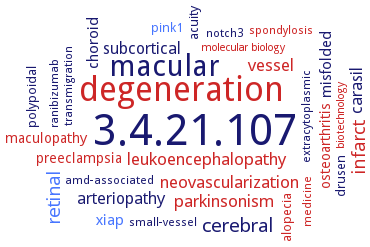3.4.21.107: peptidase Do
This is an abbreviated version!
For detailed information about peptidase Do, go to the full flat file.

Word Map on EC 3.4.21.107 
-
3.4.21.107
-
degeneration
-
macular
-
cerebral
-
retinal
-
infarct
-
neovascularization
-
vessel
-
parkinsonism
-
leukoencephalopathy
-
arteriopathy
-
subcortical
-
carasil
-
xiap
-
misfolded
-
choroid
-
osteoarthritis
-
maculopathy
-
preeclampsia
-
polypoidal
-
pink1
-
acuity
-
alopecia
-
drusen
-
medicine
-
small-vessel
-
extracytoplasmic
-
amd-associated
-
notch3
-
spondylosis
-
transmigration
-
ranibizumab
-
biotechnology
-
molecular biology
- 3.4.21.107
- degeneration
-
macular
- cerebral
- retinal
- infarct
- neovascularization
- vessel
- parkinsonism
- leukoencephalopathy
-
arteriopathy
-
subcortical
-
carasil
- xiap
-
misfolded
- choroid
- osteoarthritis
- maculopathy
- preeclampsia
-
polypoidal
- pink1
-
acuity
- alopecia
-
drusen
- medicine
-
small-vessel
-
extracytoplasmic
-
amd-associated
-
notch3
- spondylosis
-
transmigration
-
ranibizumab
- biotechnology
- molecular biology
Reaction
acts on substrates that are at least partially unfolded. The cleavage site P1 residue is normally between a pair of hydrophobic residues, such as Val-/-Val =
Synonyms
bacterial PQC factor, BB_0104, BCAL2829, CD630_32840, Deg1, DEG2, DEG5, DEG7, DEG8, Deg9, DegP, DegP protease, DegP/HtrA, DegQ, DegS, DepP9, Do, Do protease, HhoA, HhoB, high temperature requirement A, high temperature requirement A protease, high temperature requirement A1, high temperature requirement factor A, high-temperature requirement A, high-temperature requirement A protease, high-temperature requirement A-1, high-temperature requirement A1, high-temperature requirement A1 protease, high-temperature requirement factor A, HtrA, HtrA (DegP) protease, HtrA heat shock protease, HtrA protease, HTRA serine peptidase 1, HtrA-like protease, HtrA/DegP, HtrA1, HtrA2, HtrA3, HTRA4, MAL8P1.126, More, MucD, Nma111p, Omi/HtrA protease orthologue Ynm3p, protease do, protease Do-like 5, protease Do-like 8, PRSS11, S01.273, serine protease, serine protease HtrA, serine protease HtrA1, YNL123w


 results (
results ( results (
results ( top
top






